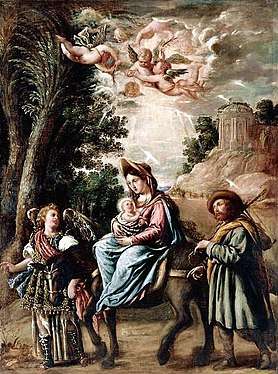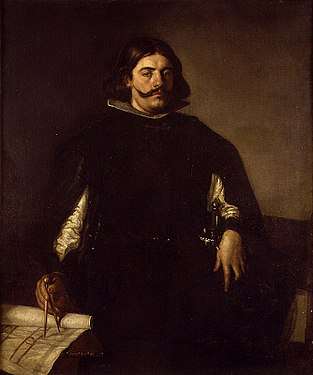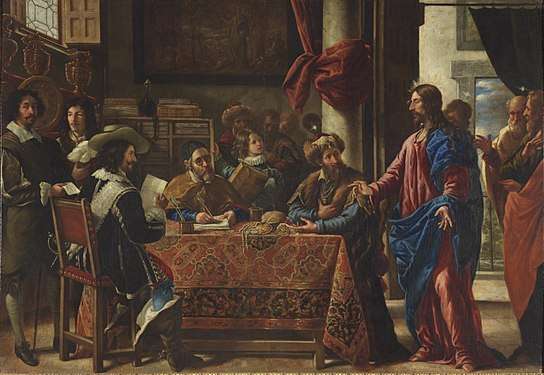Juan de Pareja
| Juan de Pareja | |
|---|---|
%2C_detalle.jpg) Detail of Velázquez's Portrait of Juan de Pareja | |
| Born |
1606 Antequera, Málaga, Spain |
| Died |
1670 (aged 63–64) Madrid, Spain |
| Education | Diego Velázquez |
| Known for | Painting |
| Movement | Baroque |
Juan de Pareja (c. 1606 in Antequera – 1670 in Madrid)[1] was a Spanish painter, born into slavery in Antequera, near Málaga, Spain. He is known primarily as a member of the household and workshop of painter Diego Velázquez, who freed him in 1650. His 1661 work The Calling of Saint Matthew (sometimes also referred to as The Vocation of Saint Matthew) is on display at the Museo del Prado in Madrid, Spain.
Pareja became Velázquez's assistant sometime after the master returned to Madrid from his first trip to Italy in January 1631. After the death of Velázquez, Pareja then became an assistant to painter Juan del Mazo.[2]
Biography
Juan de Pareja was born into slavery, the son of an enslaved African-descended woman and a white Spanish father.[3] He was described as a morisco, being "of mixed parentage and unusual color."[4] At the time morisco had two possible meanings. It referred both to descendants of Muslims who converted to Catholicism and remained in Spain after the Reconquest, and to a racial classification applied to a person with mulatto and Spanish parents, it is equivalent to English term "quadroon".
Pareja was inherited by Velázquez and became an assistant in his painting after 1631. Velázquez later freed Pareja while they were in Rome during a trip to Italy in 1650. Around the same time, Velázquez painted Pareja's portrait, which is now held in New York City.[5] The document of his manumission is held in the state archive of Rome.[6]
Only ten known works exist by Pareja.
Works
- Portrait of Agustín Moreto (1648–53), oil on canvas, Lazaro Galdiano Foundation, Madrid, Spain
- Portrait of a Monk (1651), oil on canvas, Hermitage Museum, Saint Petersburg, Russia
- The Flight into Egypt (1658), John and Mable Ringling Museum of Art, Sarasota, Florida
- The Calling of Saint Matthew (also known as The Vocation of Saint Matthew) (1661), oil on canvas, Museo del Prado, Madrid, Spain
- Saints John the Evangelist and Orontius, Augustine Collection, Madrid, Spain
- The Lady of Guadalupe, Augustine Collection, Madrid, Spain
- Portrait of the Architect José Ratés Dalmau, oil on canvas (116 x 97 cm), Museu de Belles Arts de València, Spain
- Portrait of Philip IV, King of Spain (c.1656), oil on canvas, Columbia Museum of Art, United States
- El bautismo de Cristo (1667), Museo de Huesca/Museo del Prado, Huesca, Spain
Works depicting Pareja
- Portrait of Juan de Pareja (1648), by Diego Vélazquez, Metropolitan Museum of Art, United States
- Portrait of Juan de Pareja Repairing a Mandolin String (1960), by Salvador Dalí, Minneapolis Institute of Arts, United States
Gallery
 Portrait of Agustín Moreto, (c.1648-53), 102 x 69 cm, Museum of Lázaro Galdiano
Portrait of Agustín Moreto, (c.1648-53), 102 x 69 cm, Museum of Lázaro Galdiano Portrait of a Monk (1651), 92 x 77 cm, Hermitage Museum
Portrait of a Monk (1651), 92 x 77 cm, Hermitage Museum The Flight into Egypt, (1658), 168.9 x 125.4 cm, John and Mable Ringling Museum of Art, Sarasota, Florida
The Flight into Egypt, (1658), 168.9 x 125.4 cm, John and Mable Ringling Museum of Art, Sarasota, Florida- El bautismo de Cristo, (1667) 230 x 356 cm, Museo de Huesca/Museo del Prado
 Portrait of José Ratés Dalmau, (c.1660), 116.9 x 97.8 cm, Museu de Belles Arts de València
Portrait of José Ratés Dalmau, (c.1660), 116.9 x 97.8 cm, Museu de Belles Arts de València The Calling of Saint Matthew, (1661), 225 x 325 cm, Prado Museum
The Calling of Saint Matthew, (1661), 225 x 325 cm, Prado Museum
See also
Notes
- ↑ William Stirling Maxwell (1848). Annals of the artists of Spain, Volume 2. J. Ollivier.
- ↑ The Crisis. The Crisis Publishing Company, Inc. February 1980. p. 50. ISSN 0011-1422.
- ↑ Salomon, Xavier F.; Christiansen, Keith (2016). "Velázquez (Diego Rodríguez de Silva y Velázquez) | Juan de Pareja (1606–1670) | The Met". The Metropolitan Museum of Art. Catalogue Entry: The Subject. Retrieved 2017-10-10.
- ↑ Palomino, Antonio (1988). El museo pictórico y escala óptica III. El parnaso español pintoresco laureado. Madrid : Aguilar S.A. de Ediciones
- ↑ See Carmen Fracchia's article in The Slave in European Art: From Renaissance Trophy to Abolitionist Emblem, ed Elizabeth McGrath and Jean Michel Massing, London: The Warburg Institute, and Turin, 2012.
- ↑ The document, discovered by Jennifer Montagu, is in the Archivio di Stato in Rome. See Burlington Magazine, volume 125, 1983, pp. 683-4
Sources
| Wikimedia Commons has media related to Juan de Pareja. |
- Corpus velazqueño (2000). Corpus velazqueño. Documentos y textos, 2 vols. J. M. Pita Andrade.
- Hoving, Thomas (1993). Making the Mummies Dance. Simon and Schuster.
- Palomino, Antonio (1724). El Museo pictórico y escala óptica.
- Borton de Treviño, Elizabeth (1965). I, Juan de Pareja. Bell Books. ASIN B0006BN0A0. (Juvenile novel.)